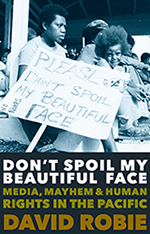
Arvind Kumar
AUCKLAND (Indian Weekender / Pacific Media Watch): The Asia-Pacific region is poorly reported and under reported in the New Zealand media and has been for years, says a leading journalism academic.Professor David Robie, director the Pacific Media Centre at the AUT University, said the mainstream and legacy media was “patchy” at best in the coverage of the region.
“The poor level of reporting means that we are frequently misinformed or we get a one-dimensional view of developments, which is barely half the story.”
Dr Robie, a media educator in the Pacific region for many years, including heading the journalism programme at the University of the South Pacific in Fiji, was speaking at a recent launch of his latest book, Don’t Spoil My Beautiful Face: Media, Mayhem and Human Rights in the Pacific.
In the book, Dr Robie, distils his lessons from 35 years of working in the Asia-Pacific region.
 Covering environmental challenges, coups, the nuclear-free and independent Pacific movement and civil rights, as well as the many barriers journalists face, Don't Spoil My Beautiful Face reveals many of the hidden stories from island nations.
Covering environmental challenges, coups, the nuclear-free and independent Pacific movement and civil rights, as well as the many barriers journalists face, Don't Spoil My Beautiful Face reveals many of the hidden stories from island nations.
“Critical development journalism is a robust form of journalism investigating political and social process and policy. It is still speaking truth to power, but as well as seeking accountability, it tries to find a constructive edge leading to solutions," he said.
Poorly reported
“The Asia-Pacific region is poorly reported and under reported in the New Zealand media and has been for years.
“Only one institution consistently covers itself with credit when covering the region and that is Radio New Zealand International. Although Māori Television’s current affairs programme Native Affairs has also done some excellent Pacific work,” he said.
“Spasifik magazine and TVNZ’s Tagata Pasifika programme also do first first class work."
Although RNZI only had a fraction of the resources of its cousin across the Tasman, Radio Australia plus ABC Television, it did an "excellent and creditable" job.
 “But with the honourable exceptions of individual journalists such as TVNZ’s Barbara Dreaver and Fairfax Media’s Michael Field – both banned by the Bainimarama regime in Fiji – the mainstream and legacy media is patchy at best in the coverage of the region,” Dr Robie said.
“But with the honourable exceptions of individual journalists such as TVNZ’s Barbara Dreaver and Fairfax Media’s Michael Field – both banned by the Bainimarama regime in Fiji – the mainstream and legacy media is patchy at best in the coverage of the region,” Dr Robie said.
“The poor level of reporting means that we are frequently misinformed or we get a one-dimensional view of developments, which is barely half the story.
“Our treatment of Fiji is an example of this. The hypocrisy and double standards over the reporting of radical changes in post-coup Fiji have not only blinded us about the realities but also prevented us seeing other critical issues around the region.
Corrupt democracy
“In many respects, the illegal Bainimarama regime has been a pariah ever since the military coup in 2006."
Dr Robie said it should not be forgotten that the so-called “democracy” that was overthrown was actually an extremist and corrupt ethno-nationalist regime masquerading as democratic.
“Also, the reality is that this same military backed regime is likely to become the elected government in the general election in September,” he said.
“Orchestrated and manipulated, perhaps. But the regime does have a lot of genuine support in rural areas and it least it opens the door to a return to real democracy.
“For the doomsayers there is very little difference from when the original coup leader Sitiveni Rabuka made the transition from hardline military dictator to elected prime minister in 1992.
“Paranoia reigns when the regime’s bureaucrats deal with the media and there is a climate of timid self-censorship in Fiji under the control of the dictatorial Media Industry Development Tribunal – except for a handful of courageous and dissident journalists such as Ricardo Morris and his Republika magazine.
“Actually Fiji is not the biggest worry in the region by a long shot,” Dr Robie said.
Journalist assassinations
“Indonesian repression in the two Melanesian provinces that make up the West Papua region and the climate of impunity in the Philippines where journalists are assassinated with ease are serious crises in the region.
“But when do you read about these issues in the New Zealand media?
“At least 206 journalists have been murdered in the Philippines since 1986—34 of them in the Ampatuan massacre in Mindanao in 2009. More than four years later nobody has been convicted for these atrocities.”
He said the Philippines was a far more dangerous place for the media under democracy than it was under the Marcos military dictatorship.
“And now a controversial law in the Philippines billed by critics as an “electronic martial law” that criminalises e-libel may be mimicked in the Pacific.”
“In Papua New Guinea the Peter O’Neill government has signalled an impending onslaught against stridently critical social media with a draft new cyber-crime law.”
He criticised New Zealand for being one of the "silent nations" over repression in West Papua and was scathing over Australia's handling of the asylum seekers issue in the Pacific.
“More than 3000 asylum seekers are living in detention camps in Nauru and Papua New Guinea deprived of their human rights and with no hope for the future.
“Through the so-called “Pacific Solution”, Australia has simply attempted to dump responsibility on two nations for a price,” he said.
“Far more investigative journalism is needed, or as I would say, more critical development journalism.”
[Abridged]Arvind Kumar is editor of the Indian Weekender.
This work is licensed under a Creative Commons Attribution-NonCommercial 3.0 New Zealand Licence.




